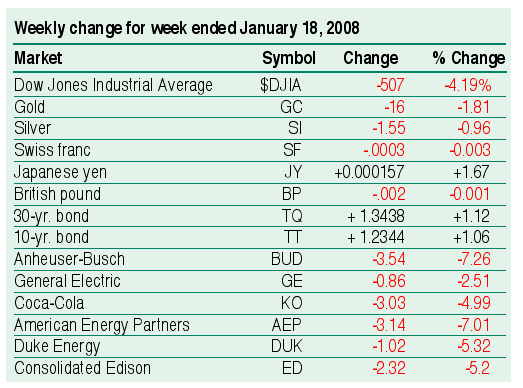Access to foreign exchange trading has opened up exciting trading options for the retail trader. You can now trade alongside corporations and institutions in a highly liquid market that is global, traded around the clock, and highly leveraged. Before jumping into this market, however, we must understand the factors that affect the forex market. With that in mind, STOCKS& COMMODITIES has introduced Forex Focus to better prepare the retail trader to participate in the currency market.
by Matthew CarusoHedging Against A Bear Market
Ever considered foreign currencies during a bear market? Here's why you should.
IT has been more than five years since the last bear market in US equities ended. The recent explosion in volatility in the markets and the 507-point, or 4.19%, one-week fall in the Dow Jones Industrial Average (DJIA) during the week of January 18, 2008, has led to many inquiries about the best way to hedge against a bear market in US equities.
Buying gold is often said to be the simple solution to hedging against a falling stock market, but gold fell $16, or 1.8%, during January's largest weekly decline. Anyone seeking shelter in gold was shocked with a loss rather than a profit to offset the weak stock market performance. Perhaps the market wisdom of hedging a falling stock market by buying gold may not be true. A good starting point in seeking the best stock market hedge would be to examine which markets would have produced a profitable alternative to equities during the stock market's large weekly decline.
PROFITABLE ALTERNATIVES
Alternative markets related to the equity markets include foreign currencies,
bonds, and precious metals. They will be examined in order to see if any
of these provided a good hedge in January's largest weekly decline as well
as in past bear markets. In addition, sectors within the market such as
consumer staple stocks and utilities are often cited as a way to sit out
market corrections due to their position in the economy and their typical
status of being large dividend payers. Therefore, stocks from these sectors
will also be studied in detail.

FIGURE 1: WEEKLY CHANGE. The only hedges during the nasty market fall were the yen, 30-year bonds, 10-year bonds, and to some degree the Swiss franc and British pound.
A list of weekly changes for the week ended January 18, 2008, of all the markets discussed is presented in Figure 1. The results show that the only hedges during the nasty market fall were the Japanese yen, 30-year US Treasury bonds, and 10-year Treasury bonds as well as to some degree the Swiss franc and British pound. Precious metals, consumer staple stocks, and utility stocks provided no hedge whatsoever. Ironically, anyone seeking shelter in consumer staple or utility stocks were hit with losses even larger than the general market.
These results show us that the common market knowledge of hedging with precious metals, certain stock sectors, or buying a basket of foreign currencies may just in fact be market myths rather than market wisdom. Now that it's evident that common market knowledge may not be correct, the performances of all the markets discussed will be examined during every major bear market in the DJIA since 1987 in order to dispel any falsehoods.
Originally published in the July 2008 issue of Technical Analysis
of STOCKS & COMMODITIES magazine. All rights reserved. © Copyright
2008, Technical Analysis, Inc.
Return to July 2008 Contents